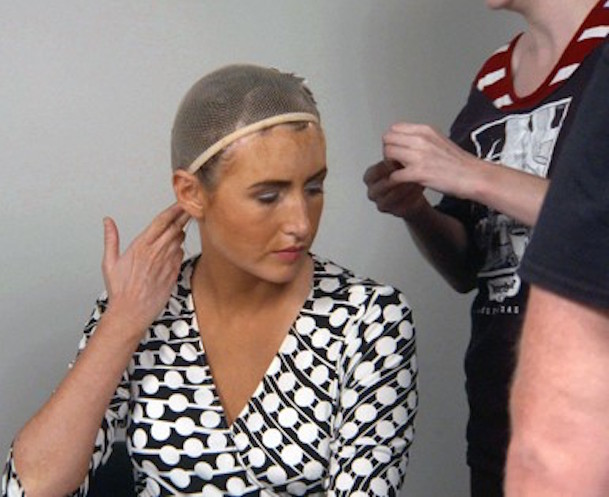Film Review: “Kate Plays Christine”
Actress Kate Lyn Sheil is the film’s focus and the audience’s guide. She travels to Sarasota to star in a biopic where she will be filmed re-enacting TV broadcaster Christine Chubbuck’s suicide.
Kate Plays Christine, directed by Robert Greene. Screening at the Brattle Theatre, November 4 through 6, Cambridge, MA.

A scene from “Kate Plays Christine.”
By Betsy Sherman
Blurring the line between narrative and non-fiction, Robert Greene’s Kate Plays Christine is a magnetic tale of investigation. It binds the viewer to the side of an actress, Kate, who’s looking for a way into the role of a real-life woman who ended her life in a public and particularly horrifying way.
Christine Chubbuck was a TV broadcaster in Sarasota, Florida, who hosted a local interview show called Suncoast Digest. On July 15, 1974, not long before her 30th birthday, she brought a revolver to work and, while doing a newscast segment, placed the gun to the base of her skull and fired. Her preface to the act was to sardonically indict the “blood and guts” tilt to the station’s coverage. Chubbuck left behind a macabre document: handwritten copy describing her “attempted suicide,” to be read by whomever next took over the microphone.
A brief Google search (no, the footage isn’t on the Web) brings up an article from the Ocala Star-Banner, looking back at the suicide three years later. In it, a male colleague minimized Chubbuck’s commentary about her employers. He said, “the crux of the situation was that she was a 29-year-old girl who wanted to be married and wasn’t.” Ouch. The ‘70s, man.
Kate Lyn Sheil, a 31-year-old New York-based actress, is the film’s focus and the audience’s guide. She travels to Sarasota to star in a biopic where, on the 41st anniversary of Chubbuck’s suicide, Kate will be filmed re-enacting it. The film’s construct is a bit of a ruse, as there is no coherent feature being shot, although there are isolated scenes involving other actors playing Christine’s mother, brother, friend, and co-workers (a Chubbuck feature is to be found elsewhere, in the forthcoming Christine, starring Rebecca Hall, which was at Sundance along with Kate Plays Christine). Kate’s ruminations, trepidation, and efforts to empathize with Chubbuck are her own but also serve as a surrogate for the filmmaker driven to launch this project in the first place. He is sometimes heard off-camera.
The actress settles uneasily into the resort city in which few people recognize Chubbuck’s name. She embarks on quests that are intellectual, physical and emotional. She does research, locating obscure articles, eventually seeing a videotape of Christine’s show. She talks to a psychologist about depression, a subject little spoken of during Christine’s time. Places exert power too: where Christine lived, where she worked, where she bought her gun (both the TV station and the gun store have moved elsewhere, but Kate’s entry into the new digs of each constitute a re-assertion of Christine’s presence).
Chubbuck was trying to make her mark in a macho, Ron Burgundy world, in which few women’s voices were taken seriously (one star female journalist, Sally Quinn, weighed in with a significant piece on Christine in the Washington Post, from which Kate reads). All of Christine’s colleagues interviewed in the film are men, and while some seem genuinely sympathetic, one wonders whether she had any real support. A reporter says she had a “hard edge” and urges Kate to give the performance a “simmering undercurrent.” A contrasting reaction to Kate’s search for understanding comes from an elderly wigmaker with a lilting foreign accent who’s fitting Kate with a dark wig while looking at a photo of Christine: she simply says to the actress, “I’m worried how you’re gonna be sad.”
Kate counts on a bodily transformation to help her gain a special kind of insight. With red hair, freckles, and blue eyes, the actress doesn’t much resemble the darker Chubbuck. We see Kate sandwiched in a tanning bed. She roams Sarasota in a ‘70s-ish t-shirt and a demure version of Daisy Dukes, viewing her surroundings through brown contact lenses. At a firing range, she accustoms her muscles to holding and shooting a gun.
The occasional scenes in which Kate acts the role of Christine dramatize moments from the broadcaster’s final days. Not really meant to be taken as great drama, they’re deliberately flat, with on-the-nose dialogue. Kate, on the phone early in the movie, tells her father she’s working on a “’70s soap opera type thing.” The supporting actors get the chance to introduce themselves and give their thoughts about Chubbuck.
Kate’s effort to empathize with Christine is tinged with terror: could she, and by extension we, ever end it all like that? Kate Plays Christine is a big improvement over Greene’s previous non-traditional documentary, Actress. He finesses that “simmering undercurrent” under a cool exterior, while also tapping into a tradition of fiction about women who exert a pull from beyond the grave, such as the classic movies Vertigo, Rebecca, and Laura. It’s a movie that leaves you wanting to find out more.
Betsy Sherman has written about movies, old and new, for The Boston Globe, The Boston Phoenix, and The Improper Bostonian, among others. She holds a degree in archives management from Simmons Graduate School of Library and Information Science. When she grows up, she wants to be Barbara Stanwyck.
Tagged: Christine Chubbuck, IFFBoston, Kate Lyn Sheil, Kate Plays Christine
